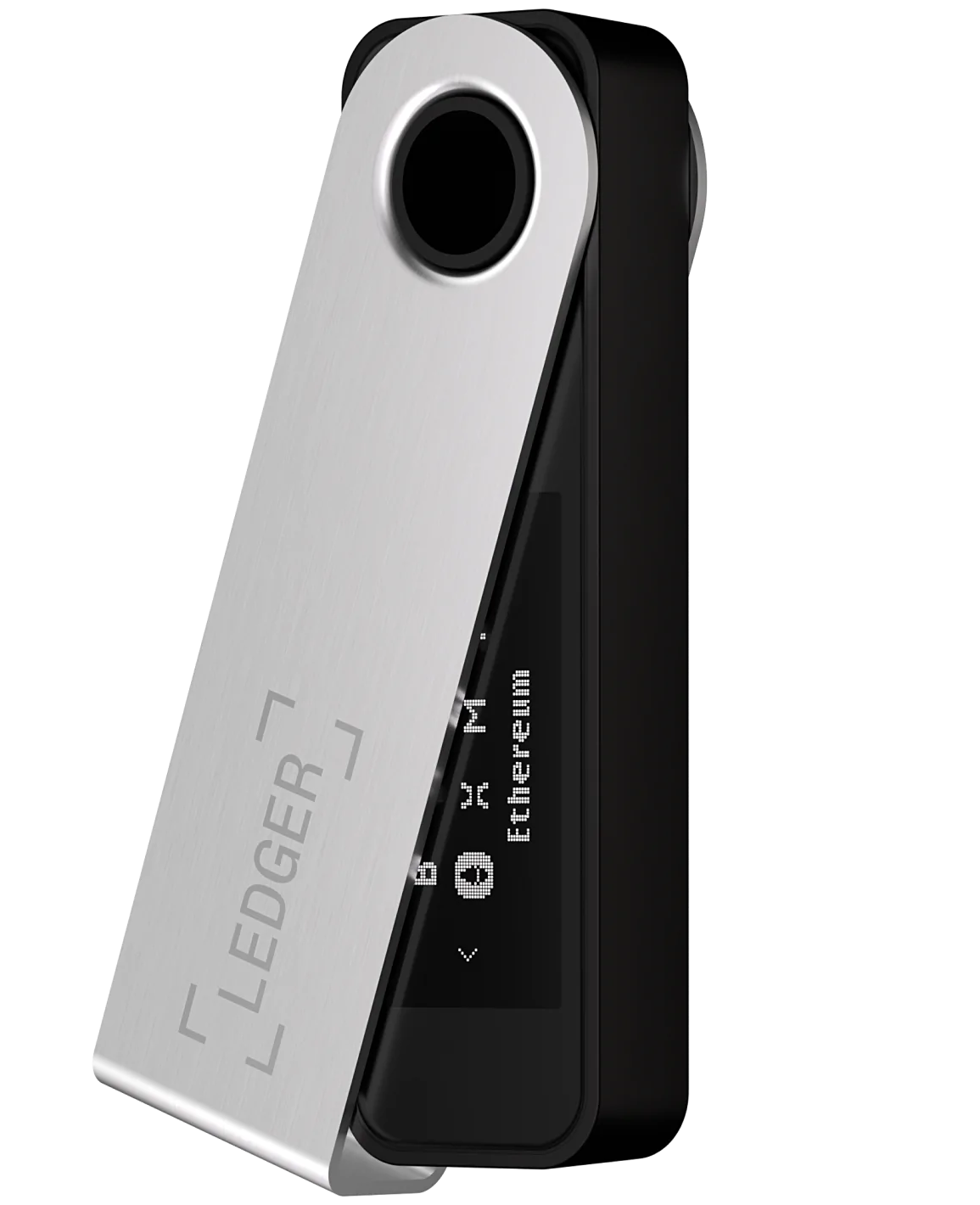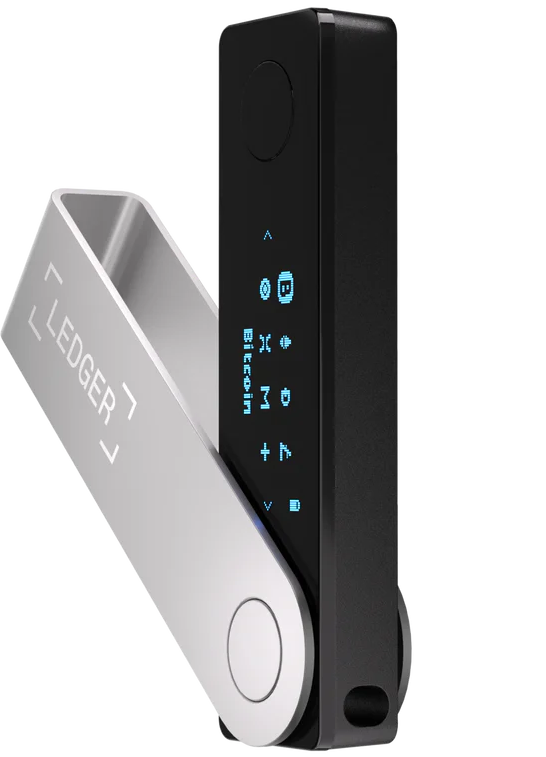Trezor vs Ledger: Which One Is the Best Multi-Coin Wallet?
Comparing the leading hardware wallets for cryptocurrency storage in 2025
After examining Bitcoin-only wallets in our previous comparison, it’s time to look at the leaders in the multicoin hardware wallet space: Trezor and Ledger. If you’re looking to secure multiple cryptocurrencies beyond just Bitcoin—perhaps accumulated via a crypto DCA strategy—this head-to-head comparison will help you choose the right device for your needs.
Let’s dive into the detailed comparison of the flagship models from both companies:

Trezor Safe 3 is the entry-level model from SatoshiLabs, pioneers in the hardware wallet space. At $79, it offers excellent value with strong security features, including an EAL6+ certified Secure Element chip. While it uses a basic two-button interface with a monochromatic screen, the wallet excels in security transparency with its fully open-source approach. The Safe 3 supports thousands of cryptocurrencies managed through Trezor Suite without needing to install apps per coin. A standout feature is Shamir Backup, allowing recovery seed splitting for enhanced security. For iOS users, there’s a limitation—the Trezor Suite app is view-only due to Apple’s restrictions on USB connections.

Trezor Safe 5 is the premium offering from Trezor, featuring a 1.54" color touchscreen with haptic feedback for significantly improved user experience. Priced at $169, it maintains the open-source approach while adding premium materials like Gorilla® Glass 3 for durability. The touchscreen makes navigation and transaction verification more intuitive than button-based alternatives. Like the Safe 3, it features the EAL6+ secure element and Shamir Backup but adds a MicroSD card slot for potential future expansions. Despite the premium features, it still requires a USB-C connection and faces the same iOS limitations as its smaller sibling.

Ledger Nano S Plus matches the Trezor Safe 3’s $79 price point as Ledger’s entry-level option. It features a button-based interface with a screen for transaction verification and uses an EAL6+ Secure Element chip, though unlike Trezor, its software is proprietary rather than open-source. The Nano S Plus shines with support for over 5,500 cryptocurrencies, managed through installing blockchain-specific apps on the device (up to 100 simultaneously). It connects via USB-C to desktops and Android smartphones using OTG cables but lacks Bluetooth connectivity. Ledger’s recovery approach uses a standard 24-word seed phrase, with optional Ledger Recover service available as a subscription.

Ledger Nano X is Ledger’s premium device at $149, featuring both USB-C and Bluetooth connectivity—a key differentiator for mobile users. The built-in battery (100mAh) enables wireless operation with iOS and Android devices through the Ledger Live app. While using a similar button interface to the Nano S Plus, it offers a larger screen for better visibility. Security-wise, it’s certified at EAL5+, slightly lower than other models but still highly secure. Like the Nano S Plus, it supports 5,500+ cryptocurrencies with app-based management and offers Ledger Recover as an optional backup service.
TL;DR:
All four wallets provide strong security for your cryptocurrencies, but with different approaches and trade-offs. Your choice depends on specific needs and preferences:
Reasons to Buy:
- Trezor Safe 3: Open-source security, affordable price, no apps needed per coin, Shamir Backup
- Trezor Safe 5: Best user interface with touchscreen, open-source, premium build quality
- Ledger Nano S Plus: Wide cryptocurrency support (5,500+), affordable entry point
- Ledger Nano X: Bluetooth for mobile use, iOS/Android support, wide cryptocurrency support
Reasons for “Nay”:
- Trezor Safe 3: Basic interface, no Bluetooth, limited iOS functionality
- Trezor Safe 5: Higher price, no Bluetooth, limited iOS functionality
- Ledger Nano S Plus: Not open-source, button interface less intuitive, no wireless
- Ledger Nano X: Not open-source, requires charging, slightly lower security certification
Comparison Table
| Feature | Trezor Safe 3 | Trezor Safe 5 | Ledger Nano S+ | Ledger Nano X |
|---|---|---|---|---|
| Price | $79 | $169 | $79 | $149 |
| Interface | 2 | 5 | 3 | 3 |
| Security (EAL) | 5 | 5 | 5 | 4 |
| Open-Source | 5 | 5 | 1 | 1 |
| Mobile Experience | 2 | 2 | 3 | 5 |
| Coin Support | 4 | 4 | 5 | 5 |
| Build Quality | 3 | 5 | 3 | 4 |
| Recovery Options | 5 | 5 | 3 | 3 |
| Ease of Setup | 4 | 5 | 4 | 4 |
| Battery-Free | 5 | 5 | 5 | 1 |
## Security Comparison
Security is the primary reason for using a hardware wallet, and both brands take different approaches:
Trezor’s Security Approach:
- Fully open-source, allowing community auditing for transparency
- EAL6+ Secure Element chips in both models
- PIN and passphrase protection with on-device entry
- Advanced Shamir Backup for multi-share recovery without third-party reliance
- Open-source philosophy extends to developing their own open-source secure element
Ledger’s Security Approach:
- Proprietary Ledger OS™ with Trusted Display
- EAL6+ certification in Nano S Plus, EAL5+ in Nano X
- Standard recovery with 24-word seed phrase
- Optional Ledger Recover subscription service for backup
- Closed-source system with established security track record
The security debate often centers on open-source versus proprietary approaches. Trezor’s transparency appeals to privacy-focused users and security experts who prefer auditable code. Ledger’s closed system has protected over 7 million customers effectively but lacks the same level of transparency. Both approaches have merit, and the choice depends on your security philosophy.
Mobile Experience
Mobile compatibility is increasingly important for cryptocurrency users:
Trezor Mobile Experience:
- USB-C connection required for all operations
- Requires OTG adapter for most phones
- iOS app is view-only due to Apple’s USB restrictions
- No wireless connectivity options
Ledger Mobile Experience:
- Nano S Plus: USB-C connection like Trezor
- Nano X: Bluetooth connectivity for wireless mobile use
- Full functionality on both Android and iOS (Nano X)
- Battery-powered operation for untethered use
Ledger Nano X clearly wins for mobile users, especially those with iOS devices. The Bluetooth connectivity provides significant convenience for managing crypto on the go. Trezor’s mobile experience is more limited, particularly on iOS where the app is view-only.
Cryptocurrency Support
Both wallets support a wide range of cryptocurrencies, but with different approaches:
Trezor Cryptocurrency Support:
- “Thousands” of coins and tokens supported
- No need to install apps per coin
- Managed through Trezor Suite
- No storage limitations for different coins
Ledger Cryptocurrency Support:
- Over 5,500 coins and tokens officially supported
- Requires installing apps for different blockchains
- Limited to around 100 apps installed simultaneously
- Potentially better for niche tokens and newer coins
Ledger offers broader cryptocurrency support, which may be crucial for users with diverse portfolios including lesser-known tokens. Trezor’s approach is simpler to manage but might not support as many niche assets.
Interface and Usability
User experience differs significantly between the models:
Trezor Interface:
- Safe 3: Basic two-button navigation with monochromatic screen
- Safe 5: Modern touchscreen with haptic feedback
- Trezor Suite desktop and mobile companion app
- Simple, consistent interface across platforms
Ledger Interface:
- Both models: Button-based navigation
- Nano X has a larger screen for better visibility
- Ledger Live companion app for management
- App-based approach may be less intuitive initially
The Trezor Safe 5 stands out with its touchscreen, making it significantly more user-friendly than button-based alternatives. For users prioritizing ease of use, this could be a deciding factor despite the higher price.
Recovery and Backup
Both offer robust recovery options with different approaches:
Trezor Recovery:
- Standard 12/24-word recovery seed
- Advanced Shamir Backup (Multi-share Backup)
- Self-custody focused without third-party services
- On-device recovery process
Ledger Recovery:
- Standard 24-word recovery seed
- Optional Ledger Recover subscription service
- Third-party reliance for advanced recovery
- Subscription model for enhanced backup
Trezor’s Shamir Backup offers a self-custody solution for advanced recovery, while Ledger’s Recover service provides convenience but requires a subscription and third-party trust. Your preference will depend on your recovery philosophy.
Price and Value Proposition
The price points reveal different value propositions:
Trezor Value:
- Entry-level: $79 for Safe 3
- Premium: $169 for Safe 5 with touchscreen
- Open-source as added value for security-focused users
- Higher premium price justified by touchscreen interface
Ledger Value:
- Entry-level: $79 for Nano S Plus
- Premium: $149 for Nano X with Bluetooth
- More supported cryptocurrencies as added value
- Premium price justified by wireless connectivity
The entry-level models are identically priced, while Trezor’s premium model costs $20 more than Ledger’s but offers a touchscreen instead of Bluetooth. Your choice depends on whether you prioritize interface or mobility.
Who Should Choose Each Wallet?
Based on this analysis, here are my recommendations:
Choose Trezor if you:
- Value open-source transparency and community auditing
- Prefer a touchscreen interface (Safe 5)
- Want advanced self-custody recovery options
- Don’t need Bluetooth connectivity
- Primarily manage your crypto from desktop computers
Choose Ledger if you:
- Need mobile management, especially on iOS (Nano X)
- Have a diverse portfolio with many different cryptocurrencies
- Want Bluetooth connectivity for wireless operation
- Are comfortable with a proprietary security approach
- Prefer subscription-based recovery services
Final Thoughts
There’s no universal “best” choice between Trezor and Ledger—both offer secure, reliable hardware wallets with different strengths. Trezor excels in transparency and user interface, while Ledger wins on mobility and cryptocurrency diversity.
For my personal use, I appreciate Trezor’s open-source approach and touchscreen on the Safe 5, but Ledger’s Bluetooth connectivity on the Nano X is compelling for mobile users. Ultimately, assess your own priorities—security philosophy, interface preferences, mobile needs, and cryptocurrency diversity—to make the choice that best suits your crypto journey.
Which hardware wallet do you use? Share your experiences in the comments below!
FAQ
Is Trezor better than Ledger? +
The answer depends on your specific needs. Trezor excels with its open-source approach, touchscreen interface on premium models, and transparent security. Ledger offers superior mobile connectivity with Bluetooth support, more cryptocurrency options, and a mature ecosystem. Neither is universally 'better' - choose based on your priorities.
Is Trezor more secure than Ledger? +
Both offer high-level security with different approaches. Trezor's open-source software allows community security audits, creating transparency many security experts prefer. Ledger uses a proprietary system with a strong security track record. Both use secure element chips, though Trezor's EAL6+ certification technically outranks Ledger Nano X's EAL5+.
Which supports more cryptocurrencies, Trezor or Ledger? +
Ledger supports more cryptocurrencies, with over 5,500 coins and tokens compared to Trezor's 'thousands.' This makes Ledger potentially better for users with diverse portfolios including many altcoins.
Can I use Trezor or Ledger with my phone? +
Both can connect to phones, but differently. Ledger Nano X offers Bluetooth for wireless connections to iOS and Android. Trezor requires USB connections via OTG adapters, and on iOS, the Trezor Suite is view-only due to Apple's limitations.
What's the price difference between Trezor and Ledger models? +
Entry-level models Trezor Safe 3 and Ledger Nano S Plus are both priced at $79. The premium models are Trezor Safe 5 at $169 and Ledger Nano X at $149. Trezor's advanced model costs $20 more but offers a touchscreen interface.
Are Trezor and Ledger easy to use for beginners? +
Both brands offer user-friendly solutions, though in different ways. Trezor Safe 5 features a touchscreen with haptic feedback that many beginners find intuitive. Ledger's companion app (Ledger Live) is well-designed but relies on button navigation on the device, which can be less intuitive initially.
—
Disclaimer: This article is for informational purposes only and does not constitute financial advice. Investing involves risks, including the possible loss of principal. Always conduct your own research before making investment decisions.
